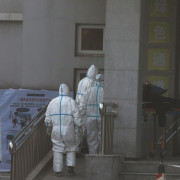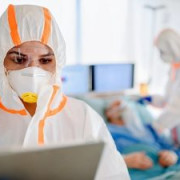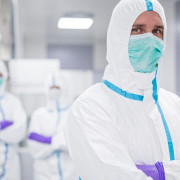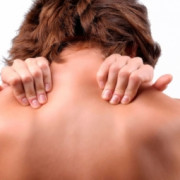Covid-19 forecasts: deaths
Содержание:
- How to order the Real-Time Reverse Transcriptase (RT)-PCR Diagnostic Panel
- Ordering Supplies (For Clinical Laboratories)
- Forecast Inclusion and Assumptions
- Stay healthy during the COVID-19 pandemic
- When home health agency personnel are involved in the care of people with confirmed or suspected COVID-19 infection at home
- Contingency Capacity Strategies
- Sharing our knowledge
- Animals that can be infected with the virus that causes COVID-19
- Clinical presentation and disease severity
- Bulk meat, poultry, and seafood purchasing and handling
- What to Do If You Are Sick
- Схема лечения Covid-19
- Materials included in the assay
- Response Goals and Objectives
- Conventional Capacity Strategies
- Pre-symptomatic and Asymptomatic Contribution to Disease Transmission
- Vaccine Development
- Поддерживающая терапия при COVID-19 в ОРИТ
How to order the Real-Time Reverse Transcriptase (RT)-PCR Diagnostic Panel
The International Reagent Resource (IRR)external icon is distributing the diagnostic panel and supplies to registered state and local public health laboratories so they can perform SARS-CoV-2 testing.
During the SARS-CoV-2 pandemic, state public health laboratories can authorize county or city laboratories in each state to perform testing. These laboratories must be certified under the Clinical Laboratory Improvement Amendment (CLIA) to perform high-complexity tests, have appropriate laboratory equipment and training, and demonstrate testing proficiency under their state laboratory’s stewardship to maintain their status as an IRR-registered laboratory. The IRR does not supply clinicians, hospitals, or healthcare professionals with testing kits directly. Clinicians, hospitals, and healthcare professionals should refer to the list of commercially available lots of primers and probespdf icon that are acceptable alternatives to the CDC-provided reagents. The list begins on page 7 in the authorized CDC 2019-nCoV Real-Time RT-PCR Diagnostic Panel Instructions for Useexternal icon Package Insert.
Ordering Supplies (For Clinical Laboratories)
Can I register my lab or hospital with IRR?
CDC limits IRR registration and SARS-CoV-2 diagnostic reagent distribution to U.S. state and local public health laboratories validated to perform SARS-CoV-2 viral testing. During the SARS-CoV-2 pandemic, CDC will defer the decision to authorize new laboratories to the corresponding state public health laboratory.
How do I obtain reagents for the CDC EUA real-time RT-PCR assay for SARS-CoV-2?
Clinical laboratories can purchase reagents for the CDC EUA real-time RT-PCR primers and probes from Integrated DNA Technologies (IDT) or Biosearch Technologies. CDC has posted a list of approved reagents and acceptable lots on the CDC COVID-19 website. Clinical laboratories also can purchase commercially developed viral tests with an EUA from the manufacturer.
Forecast Inclusion and Assumptions
The forecast included in the ensembles are displayed below. Forecasts are included when they meet a set of submission and data quality requirements, further described here: .
The forecasts make different assumptions about social distancing measures. Information about individual models is available here: https://github.com/cdcepi/COVID-19-Forecasts/blob/master/COVID-19_Forecast_Model_Descriptions.mdexternal icon. The list below includes all models that submitted a national- or state-level forecast.
Forecasts fall into one of two categories:
- These modeling groups make assumptions about how levels of social distancing will change in the future:
- Columbia Universityexternal icon (Model: Columbia)
- Covid-19 Simulator Consortiumexternal icon (Model: Covid19Sim)
- Google and Harvard School of Public Healthexternal icon (Model: Google-HSPH)
- Johns Hopkins University, Infectious Disease Dynamics Labexternal icon (Model: JHU-IDD)
- Predictive Science Inc.external icon (Model: PSI)
- University of California, Los Angelesexternal icon (Model: UCLA)
- These modeling groups assume that existing social distancing measures will continue through the projected 4-week time period:
- Bob Paganoexternal icon (Model: BPagano)
- Carnegie Mellon Delphi Groupexternal icon (Model: CMU)
- Columbia University and University of North Carolinaexternal icon (Model: Columbia-UNC)
- Discrete Dynamical Systemsexternal icon (Model: DDS)
- Georgia Institute of Technology, College of Computingexternal icon (Model: GT-DeepCOVID)
- Institute for Health Metrics and Evaluationexternal icon (Model: IHME)
- Iowa State Universityexternal icon (Model: ISU)
- Johns Hopkins University Applied Physics Labexternal icon (Model: JHU-APL)
- Johns Hopkins University, Center for Systems Science and Engineeringexternal icon (Model: JHU-CSSE)
- Karlen Working Groupexternal icon (Model: Karlen)
- London School of Hygiene and Tropical Medicineexternal icon (Model: LSHTM)
- London School of Hygiene and Tropical Medicineexternal icon (Model: LSHTM)
- Los Alamos National Laboratoryexternal icon (Model: LANL)
- Massachusetts Institute of Technology, Laboratory of Computational Physiologyexternal icon (Model: MIT-LCP)
- Massachusetts Institute of Technology, Operations Research Centerexternal icon (Model: MIT-ORC)
- Microsoft AIexternal icon (Model: Microsoft)
- Northeastern University, Laboratory for the Modeling of Biological and Socio-technical Systemsexternal icon (Model: MOBS)
- Notre Dame Universityexternal icon (Model: NotreDame-Mobility)
- Oliver Wymanexternal icon (Model: Oliver Wyman)
- Qi-Jun Hongexternal icon (Model: QJHong)
- Rensselaer Polytechnic Institute and University of Washingtonexternal icon (Model: RPI-UW)
- Robert Walravenexternal icon (Model: ESG)
- Steve McConnellexternal icon (Model: CovidComplete)
- University of Arizonaexternal icon (Model: UA)
- University of California, Mercedexternal icon (Model: UCM)
- University of California, San Diego and Northeastern Universityexternal icon (Model: UCSD-NEU)
- University of Massachusetts, Amherstexternal icon (Models: UMass-MB and Ensemble)
- University of Michiganexternal icon (Model: UM)
- (Model: USC)
- University of Texas, Austinexternal icon (Model: UT)
- Walmart Labs Data Science Teamtxt iconexternal icon (Model: Walmart)
- Wadhwani AIiexternal icon (Model: Wadhwani)
1 The full range of the prediction intervals is not visible for all state plots. Please see the forecast data for the full range of state-specific prediction intervals.
Stay healthy during the COVID-19 pandemic
Staying healthy during the pandemic is important. Talk to your healthcare provider about whether your vaccinations and other preventive services are up to date to help prevent you from becoming ill with other diseases.
- It is particularly important for those at increased risk of severe illness, including older adults, to receive recommended vaccinations against influenza and pneumococcal disease.
- Talk with your healthcare provider about maintaining preventive services like cancer screenings during the pandemic.
- Remember the importance of staying physically active and practicing healthy habits to cope with stress.
- If you have a medical emergency, do not delay seeking emergency care.
- Continue your medicines and do not change your treatment plan without talking to your healthcare provider.
- Have at least a 30-day supply of prescription and non-prescription medicines. Talk to a healthcare provider, insurer, and pharmacist about getting an extra supply (i.e., more than 30 days) of prescription medicines, if possible, to reduce your trips to the pharmacy.
- Do not delay getting emergency care for your underlying medical condition because of COVID-19. Emergency departments have contingency infection prevention plans to protect you from getting COVID-19 if you need care.
- Call your healthcare provider if you have any concerns about your underlying medical conditions or if you get sick and think that you may have COVID-19. If you need emergency help, call 911 right away.
- If you don’t have a healthcare provider, contact your nearest community health centerexternal icon or health department.
box tissue light icon
Getting a flu vaccine during 2020-2021 is more important than ever because of the ongoing COVID-19 pandemic. Flu vaccination is especially important for people who are at high risk from flu; many of whom are also at high risk for COVID-19 or serious outcomes.
When home health agency personnel are involved in the care of people with confirmed or suspected COVID-19 infection at home
- Adhere to relevant infection prevention and control (IPC) practices as described in the Interim Infection Prevention and Control Recommendations for Healthcare Personnel During the Coronavirus Disease 2019 (COVID-19) Pandemic.
- Refer to the Interim Guidance on Testing Healthcare Personnel for SARS-CoV-2 for questions about testing.
- Following possible exposures to SARS-CoV-2 while providing patient care, home health agency personnel can refer to the Interim U.S. Guidance for Risk Assessment and Work Restrictions for Healthcare Personnel with Potential Exposure to COVID-19 for information on recommended work restrictions.
- For more information, the Centers for Medicare & Medicaid Services (CMS) has provided Guidance for Infection Control and Prevention Concerning Coronavirus Disease 2019 (COVID-19) in Home Health Agencies (HHAs) and Religious Nonmedical Healthcare Institutions (RNHCIs)pdf iconexternal icon.
Footnotes
1Isolation is defined as the separation of a sick person with contagious disease, with restriction of that person’s activities, from those who are not sick.
Contingency Capacity Strategies
Selectively cancel elective and non-urgent procedures and appointments for which a facemask is typically used by HCP as PPE.
Remove facemasks from facility entrances and other public areas.
Healthcare facilities can consider removing all facemasks from public areas (e.g., entrances, near elevators) and instead keep them in a secure and monitored site where they are distributed at check-in only to patients who do not have their own cloth mask or facemask. This is especially important in high-traffic areas like emergency departments.
Implement extended use of facemasks as PPE.
Extended use of facemasks is the practice of HCP wearing the same facemask as PPE (e.g., for patients on Droplet Precautions) during encounters with several different patients, without removing the facemask between encounters.
- The facemask should be discarded whenever the facemask is removed, and always at the end of each workday.
- The facemask should also be removed and discarded if soiled, damaged, or hard to breathe through.
- HCP must take care not to touch their facemask. If they touch or adjust their facemask, they must immediately perform hand hygiene.
- HCP should leave the patient care area if they need to remove the facemask.
Restrict facemasks for use only by HCP when needed as PPE (e.g., encounters with patients on Droplet Precautions).
HCP who only require source control may use a cloth mask. Instead of providing a facemask to patients not already wearing their own cloth mask for source control, have them use tissues or other barriers to cover their mouth and nose
Sharing our knowledge
From the beginning of the pandemic, CDC has been at the forefront of sharing what we’ve learned about COVID-19.
- provides daily numbers and tools to analyze COVID-19 cases, deaths, and trends at the local, state, and national levels.
- The Household Pulse Survey, a joint effort by CDC and the US Census Bureau, produces a real-time snapshot of people’s mental health and access to care during the pandemic. About 100,000 people a week have answered questions about their physical and mental health, as well as job status, spending, and education. The result is a 50-state picture that can be broken down by geography, age, gender, race and ethnicity, and educational level.
- CDC is leading the SARS-CoV-2 Sequencing for Public Health Emergency Response, Epidemiology and Surveillance (SPHERES). This new national genomics consortium will coordinate large-scale, rapid genomic sequencing of the virus that causes COVID-19, allowing public health experts to monitor any changes to the virus, learn more about how it spreads and help identify ways to diagnose and treat the disease.
- CDC developed an rRT-PCR test to diagnose current COVID-19 infection and has helped equip state and local public health laboratories with the capacity to test people for the virus.
- CDC has developed a laboratory serology (antibody) test to help estimate how many people in the United States have been infected with SARS-CoV-2, the virus that causes COVID-19.
- This test examines blood samples for proteins your body makes in response to an infection.
- It’s designed to estimate how much of the U.S. population has been infected with the virus and learn how the body’s immune system responds to the virus.
- CDC has grown the virus that causes COVID-19 in cell culture, a necessary step for further studies. The cell-grown virus was sent to the National Institutes of Health’s BEI Resources Repository external iconfor use by the broad scientific community.
- CDC’s COVIDView page provides weekly updates on testing, hospitalizations, and mortality for COVID-19-like illness (CLI) and influenza-like illness (ILI) nationwide.
In addition:
- CDC’s COVID-NET program provides standardized national data on laboratory-confirmed hospitalizations.
- CDC’s Morbidity and Mortality Weekly Report publishes the results of COVID-19 outbreak investigations.
- CDC’s scientific journal Emerging Infectious Diseases has published dozens of studies by researchers studying COVID-19 since the pandemic began.
Animals that can be infected with the virus that causes COVID-19
We know that cats, dogs, and some other mammals can be infected with SARS-CoV-2, but we don’t yet know all of the animals that can get infected. There have been reports of animals being infected with the virus worldwide.
- A small number of pet cats and dogs have been reported to be infected with SARS-CoV-2 in several countries, including the United States. Most of these pets became sick after contact with people with COVID-19.
- Large cats in captivity have tested positive for SARS-CoV-2. Several lions and tigers in a New York zooexternal icon, a puma in South Africa, and tigers in a Tennessee zoopdf iconexternal icon tested positive for SARS-CoV-2 after showing signs of respiratory illness. It is suspected that these large cats became sick after being exposed to zoo employees with COVID-19.
Mink and SARS-CoV-2
- SARS-CoV-2 has been reported in mink on farms in multiple countriesexternal icon, including the United States.
- Respiratory disease and increases in deaths have been seen in farmed mink with SARS-CoV-2 infection.
- Because some workers on these farms had COVID-19, it is likely that infected farm workers were the initial source of the mink infections.
- Once the virus is introduced on a farm, spread can occur between mink as well as from mink to other animals on the farm (dogs, cats).
- Currently, there is no evidence that animals play a significant role in the spread of SARS-CoV-2 to people. However, reports from infected mink farms in the Netherlands and Denmark suggest that in these environments there is the possibility for spread of SARS-CoV-2 from mink to humans.
- Worker safety is critical to protect people and animals on mink farms. Mink farm workers with suspected or confirmed COVID-19 should avoid contact with animals, including mink, and should follow available guidance for farmed mink and other mustelids to avoid introducing SARS-CoV-2 to mink on farms.
- Guidance developed collaboratively by the U.S. Department of Agriculture (USDA), CDC, and state animal and public health partners using a One Health approach is available to protect worker and animal health:
- Prevent Introduction of SARS-CoV-2 on Mink Farms: Interim SARS-CoV-2 Guidance and Recommendations for Farmed Mink and Other Mustelidspdf iconexternal icon
- Response and Containment Guidelines: Interim Guidance for Animal Health and Public Health Officials Managing Farmed Mink and other Farmed Mustelids with SARS-CoV-2pdf iconexternal icon
- Guidance developed collaboratively by the U.S. Department of Agriculture (USDA), CDC, and state animal and public health partners using a One Health approach is available to protect worker and animal health:
- CDC deployed One Health teams to multiple states to support state and local departments of health and agriculture, federal partners, and others in conducting on-farm investigations into people and multiple animal species with SARS-CoV-2 infection. These investigations are ongoing and will help us learn more about the transmission dynamics among mink, other animals, and people.
The U.S. Department of Agriculture (USDA) maintains a listexternal iconexternal icon of all animals and mink farms in the United States with SARS-CoV-2 infections confirmed by their National Veterinary Services Laboratories.
Clinical presentation and disease severity
Reported signs among neonates with SARS-CoV-2 infection include fever, lethargy, rhinorrhea, cough, tachypnea, increased work of breathing, vomiting, diarrhea, and poor feeding. The extent to which SARS-CoV-2 infection contributed to the reported signs of infection and complications is unclear, as many of these findings are common in term and preterm infants for other reasons (e.g., transient tachypnea of the newborn, neonatal respiratory distress syndrome).
Current evidence suggests that SARS-CoV-2 infections in neonates are uncommon. If neonates do become infected, the majority have either asymptomatic infections or mild disease (i.e., do not require respiratory support), and they recover. Severe illness in neonates, including illness requiring mechanical ventilation, has been reported but appears to be rare. Neonates with underlying medical conditions and preterm infants (<37 weeks gestational age) may be at higher risk of severe illness from COVID-19.
Bulk meat, poultry, and seafood purchasing and handling
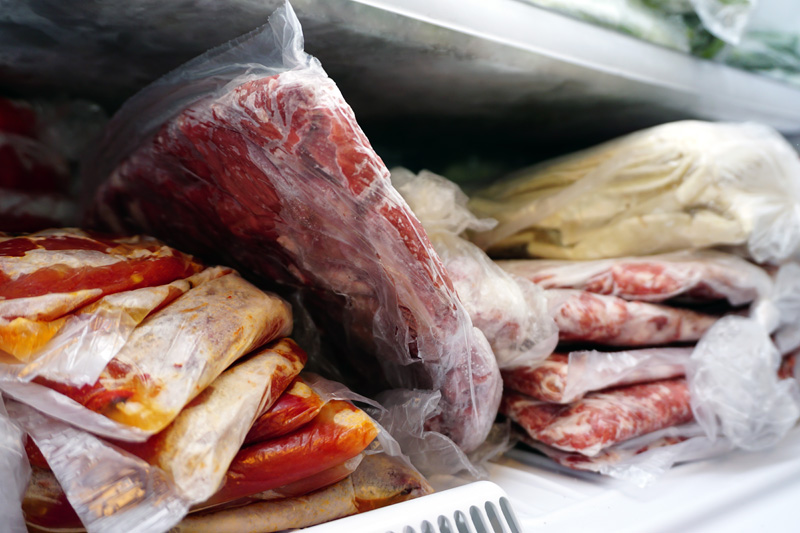
In response to changes in the food supply chain, some meat and poultry manufacturers, restaurants, and restaurant suppliers have begun selling large amounts of meat, poultry, and seafood directly to consumers. While there is currently no evidence that food can spread the virus that causes COVID-19, there are other important considerations for bulk purchasing.
- Harmful bacteria grow fastest between 41°F and 140°F. If you are picking up a meat, poultry or seafood order, bring a cooler and ice packs to keep food at 41°F or colder during transit.
- Never allow meat, poultry or seafood that requires refrigeration to sit at room temperature for more than two hours. Never allow meat, poultry, or seafood that requires refrigeration to sit at room temperature for more than one hour if the air temperature is above 90°F.
- Once you arrive home, meat, poultry and seafood items should either be prepared immediately or put in the refrigerator or freezer for safe storage.
- In case of leaks in the packaging, bring a secondary container or place cases of meat, poultry, or seafood in an area of your vehicle that can be easily clean and sanitized. If leaks occur, thoroughly wash the surface with hot, soapy water or a bleach solution after it comes in contact with raw meat, poultry or seafood, or its juices.
What to Do If You Are Sick
may show up 2‑14 days after exposure. The steps you should take if you think you are sick with COVID‑19 depend on whether you have a higher risk of developing severe illness.
High-Risk Individuals:
- Older adults and/or people of any age with certain medical conditions are at a higher risk for getting very sick from COVID‑19.People Who Are at Increased Risk for Severe Illness (CDC)
- If you are a high-risk individual and you develop fever or symptoms, call your doctor.
- If you are not sick enough to be hospitalized, you can recover at home. Follow your doctor’s instructions and refer to CDC recommendations for how to take care of yourself at home.
General Population:
- If you are in generally good health and have mild symptoms, stay home and take care of yourself like you would for a cold or the flu.
- If symptoms worsen, call your doctor.
If you are sick or are caring for someone who is sick, you can use the COVID-19 Self-Checker on the DSHS Texas Health Trace application to help you make decisions about seeking appropriate medical care.
If you need help finding a doctor or accessing medical care, call 2‑1‑1 and they can direct you to low- or no-cost providers in your area.
See the CDC website for more information on how to take care of yourself and others at home if sick:
If You Are Sick or Caring for SomeoneCDC.gov
Caring for Yourself at HomeCDC.gov
Caring for Someone at HomeCDC.gov
Information on disinfecting your home and vehicle and disposing of contaminated waste if someone is sick can also be found on the CDC and TCEQ websites:Disinfecting Your Home (CDC) Disinfecting Non-Emergency Transport Vehicles (CDC) Disposal of COVID-19 Contaminated Waste (TCEQ)
See also the CDC Reopening Guidance for Cleaning and Disinfecting Public Spaces, Workplaces, Businesses, Schools, and Homes.
Схема лечения Covid-19
Терапевтическая схема против коронавируса предполагает выполнение следующих рекомендаций:
- При сатурации менее 94% показано применение Ремдесивира, который используется только в стационаре.
- Низкие показатели оксигенации требуют срочного подключения кислородного питания и ИВЛ.
- Пока не подтверждена коронавирусная инфекция, применяется общепринятая терапия ОРВИ – интраназальное применение препаратов интерферона и его индукторов, а также медикаменты противовирусного действия.
- Для профилактики ковидной инфекции назначают Гепарин в нефракционированной или низкомолекулярной форме.
При лёгкой форме инфекционного процесса пациентам назначаются профилактические препараты, предотвращающие тромбообразующие процессы.
Если терапия проводилась в стационаре, то при явном улучшении состояния больного отрицательных результатов тестирования уже не ждут. Если лихорадка прекратилась, пропали симптомы усиления недостаточности дыхания, то пациента выписывают на домашнее долечивание.
Рекомендации постоянно меняются, дополняются и обновляются. Но в каждой новой версии прописываются всё более эффективные и усовершенствованные схемы лечения.
Materials included in the assay
Setting up a Flu SC2 Multiplex Assay Template
Analysis of the Flu SC2 Multiplex Assay Template
The CDC Flu SC2 Multiplex Assay is a quadruplex assay that includes:
- One primer mix and one probe mix. Primers and probes target:
- Virus nucleocapsid (N) gene for specific detection of SARS-CoV-2
- Matrix (M1) gene for specific detection of influenza A virus
- Nonstructural 2 (NS2) gene for specific detection of influenza B virus
- RNase P gene (RP) for specific detection of human nucleic acid that serves as an internal control
- Positive controls: SC2PC and Seasonal Influenza Positive Control (SIPC), that together confirm all four targets in the assay are working correctly
Response Goals and Objectives
The goals of CDC’s global response to COVID-19 are to limit human-to-human transmission, minimize the impact of COVID-19 in vulnerable countries with limited preparedness capacity, and reduce specific threats that pose current and future risk to the United States.
CDC’s global COVID-19 response works toward these goals by meeting the following objectives:
- Strengthen capacity to prevent, detect, and respond to local COVID-19 cases, including getting timelier and more accurate data to inform public health decision-making and strengthening the public health workforce globally
- Mitigate COVID-19 transmission in the community, across borders, and in healthcare facilities; prevent transmission of COVID-19 in healthcare facilities, among healthcare workers and public health personnel and minimize disruptions to essential health services
- Contribute to the scientific understanding of COVID-19 and address crucial unknowns regarding clinical severity, extent and pathways of transmission, and infection with support for special investigations
- Ensure readiness to implement and evaluate vaccination programs and use therapeutics when available
Conventional Capacity Strategies
Use facemasks according to product labeling and local, state, and federal requirements.
In healthcare settings, facemasks are used by HCP for 2 general purposes:
- As PPE to protect their nose and mouth from exposure to splashes, sprays, splatter, and respiratory secretions (e.g., for patients on Droplet Precautions). When used for this purpose, facemasks should be removed and discarded after each patient encounter.
- When recommended for source control while they are in the healthcare facility, to cover one’s mouth and nose to prevent spread of respiratory secretions when they are talking, sneezing, or coughing. When used for this purpose, facemasks may be used until they become soiled, damaged, or hard to breathe through. They should be immediately discarded after removal.
FDA-cleared surgical masks are designed to protect against splashes and sprays and are prioritized for use when such exposures are anticipated, including surgical procedures. Facemasks that are not regulated by FDA, such as some procedure masks, which are typically used for isolation purposes, may not provide protection against splashes and sprays.
Pre-symptomatic and Asymptomatic Contribution to Disease Transmission
A pre-symptomatic case of COVID-19 is an individual infected with SARS-CoV-2, who has not exhibited symptoms at the time of testing, but who later exhibits symptoms during the course of the infection. An asymptomatic case is an individual infected with SARS-CoV-2, who does not exhibit symptoms during the course of infection. Parameter values that measure the pre-symptomatic and asymptomatic contribution to disease transmission include:
- Percentage of infections that are asymptomatic: The percentage of persons who are infected with SARS-CoV-2 but never show symptoms of disease. Asymptomatic cases are challenging to identify because individuals do not know they are infected unless they are tested over the course of their infection, which is typically only done systematically as a part of a scientific study.
- Infectiousness of asymptomatic individuals relative to symptomatic individuals: The contribution to transmission of SARS-CoV-2 from asymptomatic individuals compared to the contribution to transmission of SARS-CoV-2 from symptomatic individuals. For example, a parameter value of 50% means that an asymptomatic individual is half as infectious as a symptomatic individual, whereas a parameter value of 100% means that an asymptomatic individual is just as likely to transmit infection as a symptomatic individual.
- Percentage of transmission occurring prior to symptom onset: Among symptomatic cases, the percentage of new cases of COVID-19 due to transmission from a person with COVID-19 who infects others before exhibiting symptoms (pre-symptomatic).
Parameter values that do not vary across the five Pandemic Planning Scenarios () are:
- Level of pre-existing immunity to COVID-19 in the community: The percentage of the U.S. population that had existing immunity to COVID-19 prior to the start of the pandemic beginning in 2019.
- Ratio of estimated infections to reported case counts: The estimated number of infections divided by the number of reported cases. The level of case detection likely varies by the age distribution of cases, location, and over time.
- Time from exposure to symptom onset: The number of days from the time a person has contact with an infected person that results in COVID-19 infection and the first appearance of symptoms.
- Time from symptom onset in an individual and symptom onset of a second person infected by that individual: The number of days from the time a person becomes symptomatic and when the person who they infect becomes symptomatic.
Additional parameter values common to the five COVID-19 Pandemic Planning Scenarios are these ten measures of healthcare usage:
- Median number of days from symptom onset to SARS-CoV-2 test among SARS-CoV-2 positive patients
- Median number of days from symptom onset to hospitalization
- Median number of days of hospitalization among those not admitted to the ICU
- Median number of days of hospitalization among those admitted to the ICU
- Percentage of patients admitted to the ICU among those hospitalized
- Percentage of patients on mechanical ventilation among those hospitalized (includes both non-ICU and ICU admissions)
- Percentage of patients who die among those hospitalized (includes both non-ICU and ICU admissions)
- Median number of days on mechanical ventilation
- Median number of days from symptom onset to death
- Median number of days from death to reporting of that death
These healthcare-related parameters () are included to assist in assessment of resource needs as the pandemic progresses.
Vaccine Development
How many COVID-19 vaccines are under development?
Multiple COVID-19 vaccines are under development. As of November 24, 2020, large-scale (Phase 3) clinical trials are in progress or being planned for five COVID-19 vaccines in the United States.
Has there been a coronavirus vaccine developed before? What’s known about it, and can it be helpful today in working toward a COVID-19 vaccine?
Severe acute respiratory syndrome (SARS) and Middle East respiratory syndrome (MERS) are two diseases caused by coronaviruses that are closely related to the virus that causes COVID-19. Researchers began working on developing vaccines for these diseases after they were discovered in 2003 and 2012, respectively. None of the SARS vaccines ever made it past the first stages of development and testing, in large part due to lack of interest because the virus disappeared. One MERS vaccine (MVA-MERS-S) successfully completed a phase 1 clinical trial in 2019. Lessons learned from this earlier vaccine research have been used to inform strategies for developing a COVID-19 vaccine.
Why is it taking so long to develop a COVID-19 vaccine? It only took a few months for the H1N1 influenza (flu) vaccine to be developed.
When a new flu strain is identified, like H1N1 in 2009, vaccine manufacturers can use the same processes that are used to make the annual seasonal flu vaccine, saving valuable time. Unlike flu, coronaviruses do not yet have licensed vaccines or processes to build on. In addition, the coronavirus that causes COVID-19 is a new virus, so entirely new vaccines must be developed and tested to ensure they work and are safe. There are many steps in the vaccine testing and approval process. Multiple agencies and groups in the United Statesexternal iconexternal icon are working together to make sure that a safe and effective COVID-19 vaccine is available as quickly as possible.
Поддерживающая терапия при COVID-19 в ОРИТ
В отделении реанимации и интенсивной терапии взрослым пациентам с COVID-19 назначают поддерживающую инфузионную терапию и гемодинамическую поддержку, для проведения которых ESICM дает следующие рекомендации:
- Больным с коронавирусной инфекцией и шоком следует измерять динамические параметры (температура, время наполнения капилляров, анализ лактата в крови (сыворотки) для сравнения со статическими показателями, чтобы оценить ответ на инфузионную терапию)
- Пациентам с COVID-19 и шоком для неотложной ресусцитации предпочтение отдается консервативной стратегии инфузионной терапии, а не либеральной стратегии
- Больным с короновирусной инфекцией и шоком при необходимости проведения неотложной ресусцитации рекомендуется применять кристаллоиды, а не коллоиды.
- При коронавирусной инфекции и шоке для неотложной ресусцитации следует отдавать предпочтение сбалансированным / буферизированным кристаллоидам, а не несбалансированным кристаллоидам
- При коронавирусной инфекции и шоке для неотложной ресусцитации НЕ РЕКОМЕНДУЕТСЯ использовать гидроксиэтилкрахмал
- При COVID-19 и шоке для неотложной ресусцитации НЕ РЕКОМЕНДУЕТСЯ использовать декстран
- При COVID-19 и шоке для начальной ресусцитации ПРОТИВОПОКАЗАНО использовать альбумин
- При коронавирусной инфекции и шоке в качестве вазопрессора первой линии рекомендуется отдавать преимущество норадреналину
- Если норадреналин недоступен, в качестве вазопрессора первой линии рекомендуется применять адреналин или антидиуретический гормон (вазопрессин)
- При коронавирусной инфекции и шоке НЕ РЕКОМЕНДУЕТСЯ назначать дофамин при условии наличия норадреналина, адреналина или вазопрессина
- При коронавирусной инфекции и шоке рекомендуется отдавать преимущество использованию вазопрессина в качестве средства второго линии, а не титровать дозу норадреналина, если целевое значение показателя среднего артериального давления не достигается путем применения только норадреналина
- При коронавирусной инфекции и шоке рекомендуется поддерживать уровень среднего артериального давления в пределах 65-70 мм рт ст
- При наличии признаков сердечной дисфункции и персистирующей гипоперфузии у больных с COVID-19 и шоком, несмотря на инфузионную терапию и применение норадреналина, рекомендуется отдавать предпочтение добавлению добутамина, а не повышением дозы норадреналина
- При рефрактерном шоке рекомендуется применять низкие дозы кортикостероидов
Стандартная схема назначения кортикостероидов при септическом шоке: ГИДРОКАРТИЗОН – 200 мг в сутки внутривенной (болюсно или капельно)
